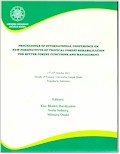| Paper |
 |
|
| Title | Aspects of ecosystem recovery in human-dominated tropical landscape: case study of degraded tropical peat-swamp forest in Ex Mega Rice Project, Central Kalimantan, Indonesia | | Author | Endri Martini | | Editor | Eko Bhakti Hardiyanto, Svein Solberg and Mitsuru Osaki | | Year | 2011 | | Parent Title | Proceedings of international conference on new perpectives of tropical forest rehabilitation for better forest functions and management | | Publisher | Faculty of Forestry, Gadjah Mada University | | City of Publication | Yogyakarta, Indonesia | | Pages | 166-169 | | Call Number | PP0310-12 |
|
| Abstract: |
| Knowledge on ecosystem recovery processes supports the efficacy of ecological restoration
program like forest rehabilitation. However, in reality, ecosystems recovery process receives less
attention in the design of ecological restoration program. Thus, based on literature review, case
study in the rehabilitation of degraded peat swamp forest Ex Mega Rice Project in Central
Kalimantan, Indonesia was reviewed to discuss the gap between current concepts of ecosystem
recovery with the real conditions on the ground. Information collected through this study is
useful for planning, implementing and monitoring the long term ecosystem recovery process of
degraded tropical forest. From the analysis, this paper concluded that degree of degradation,
ecosystem resiliency and ecosystem sensitivity are the major ecological aspects in ecosystem
recovery. However, the dynamics of the degraded ecosystem determines the possibility of the
ecosystem to be restored to its historical state. Moreover, maintaining long term ecosystem
recovery process is challenged by time and costs, however community involvement may reduce
the challenges. Making the restoration program as a local livelihood-oriented program may
become one of the options to enhance the community participation. Hence, to improve the
ecosystem services in the degraded ecosystems, both ecological and social aspects need to be addressed particularly in phase of determining the goals of the program. |
|